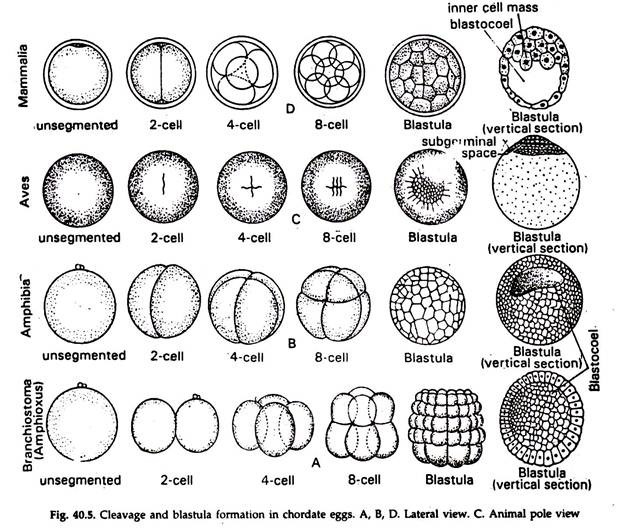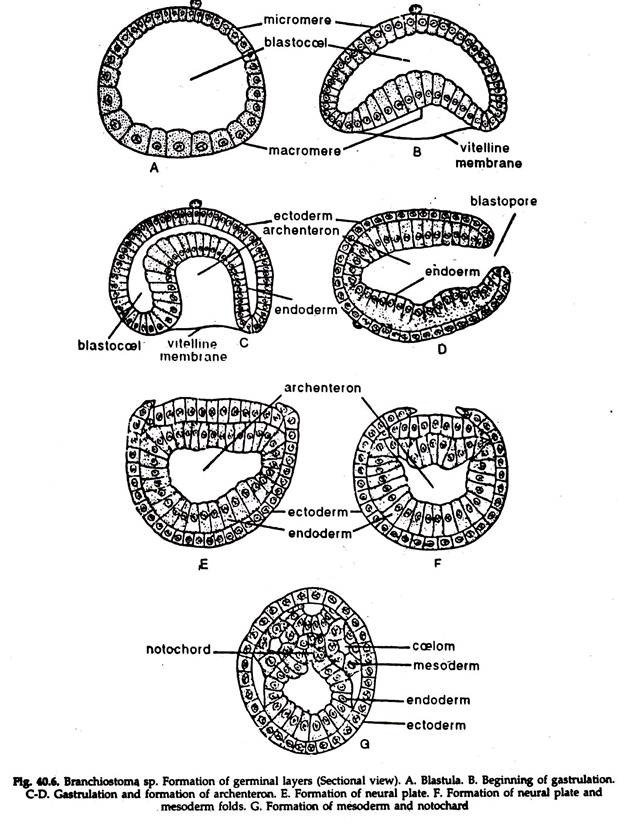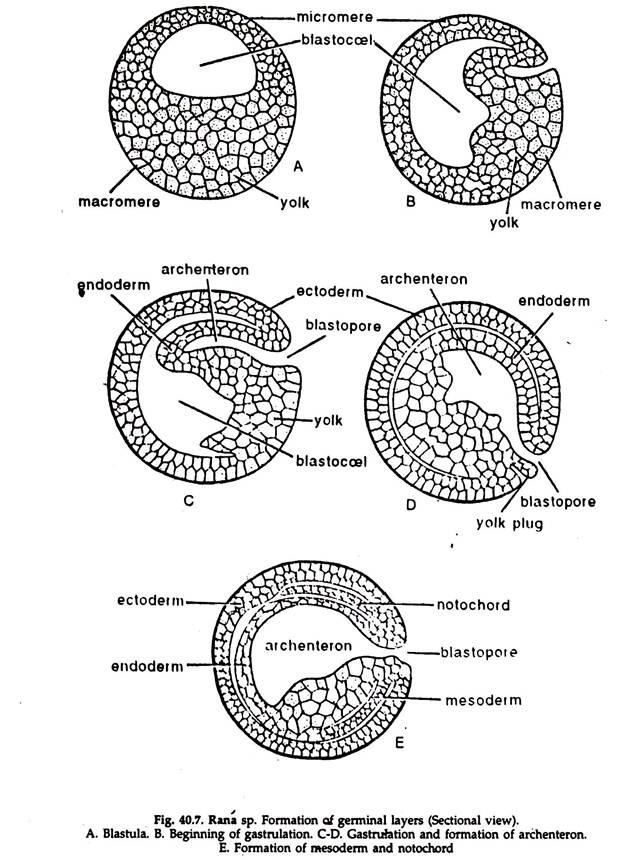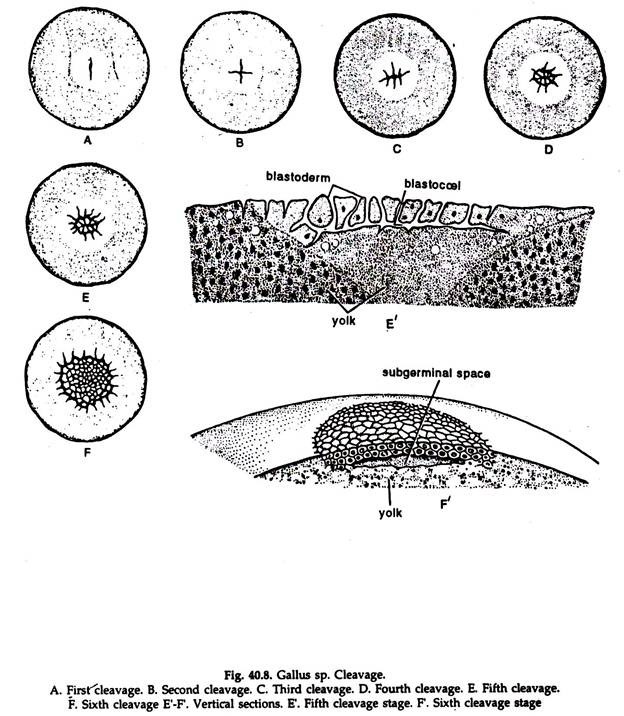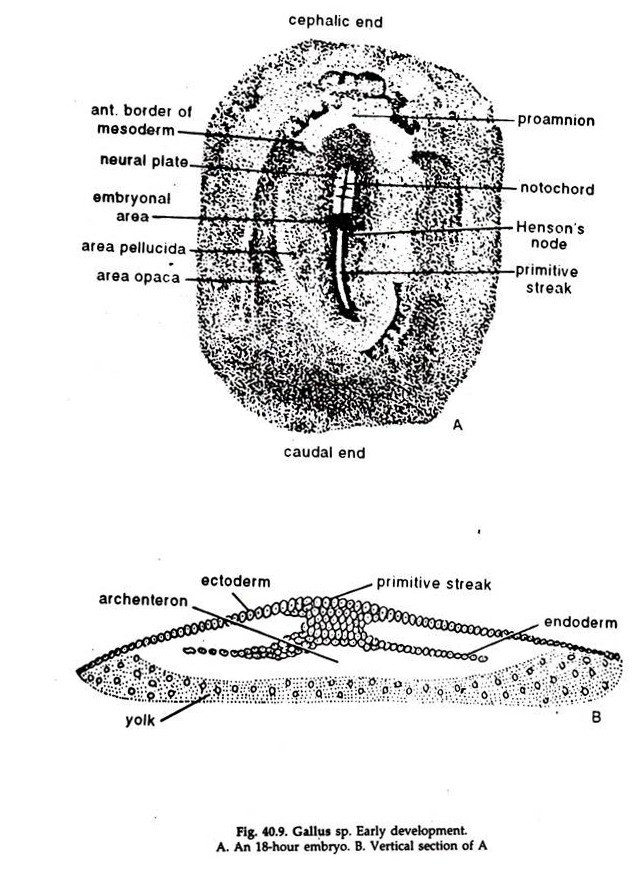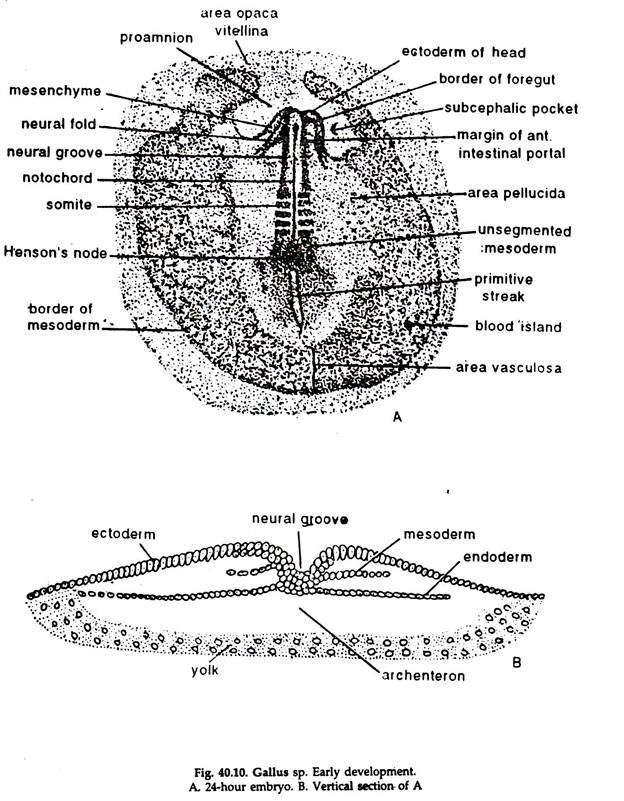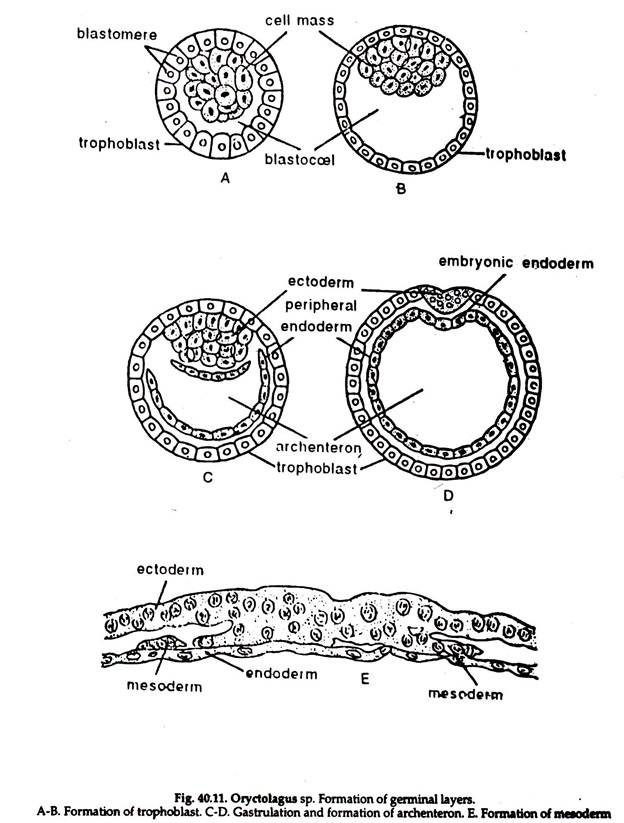In this article we will discuss about the segmentation in animals, explained with the help of suitable diagrams.
Introduction to Segmentation:
The life of a multicellular individual starts with the zygote. The zygote undergoes repeated mitotic divisions, cleavage or segmentation following a particular pattern, which varies to some extent in different groups of animals (Fig. 40.5).
The amount and distribution of yolk in the egg also influence the mode of division. The daughter cells formed by the divisions of the zygote are known as blastomeres. The small blastomeres are called micromeres and the large ones macromeres. As a rule, the micromeres are formed in the animal pole and the macromeres in the vegetal pole.
The plane of division of the zygote:
The early cleavage takes place along a predestined plane, which differs in different groups of animals.
Meridional cleavage:
The cleavage furrow starts at the middle of the animal pole and ends in the vegetal pole dividing the zygote into two equal blastomeres. In the majority of the animals the first cleavage is meridional.
ADVERTISEMENTS:
Vertical cleavage:
The cleavage plane is similar to that of the meridional cleavage but the cleavage furrow proceeds along a line lateral to the axis cutting both the poles. The blastomeres are of unequal size. In rabbit, the first cleavage is vertical.
Equatorial cleavage:
The cleavage furrow proceeds along the equator of the zygote, producing blastomeres of equal size.
ADVERTISEMENTS:
Latitudinal cleavage:
The cleavage occurs in a plane parallel to the equator of the zygote latitude, nearer to the animal pole producing micro-and macromeres.
The types of cleavage:
The amount and distribution of the inert yolk influence the types of cleavage.
Holoblastic or complete cleavage:
The cleavage is complete involving the whole of the zygote and distinctly separate (but not separated from one another) blastomeres are formed. This occurs in homolecithal eggs.
Holoblastic segmentation may be:
Equal:
The blastomeres produced are of equal sizes. The cleavage may be lateral, radial and spiral.
ADVERTISEMENTS:
Unequal:
The blastomeres produced are of unequal sizes.
Meroblastic or incomplete cleavage:
The division is incomplete and occurs in telolecithal eggs. The inert yolk occupying the vegetal pole does not divide and the division is restricted to the cytoplasmic part of the zygote in the animal pole.
Transitional cleavage:
The cleavage is transitional between holo- and meroblastic cleavage.
Segmentation: Formation of three germinal layers:
A. Branchiostoma ,
B. Rana (frog),
C. Gallus (chick) and
D. Oryctolagus (rabbit)
The three layers of cells which are produced by the arrangement of cells or blastomeres formed due to cleavage or repeated mitotic divisions of the zygote are known as the three germinal layers. Presence of three germinal layers is characteristic of all triploblastic animals and all the different organs of an animal are produced form these three germinal layers, by a process known as organogeny or organ formation.
A. Branchiostoma (Fig 40.6):
1. The egg is telolecithal, the small amount of yolk is restricted to one pole. Impregnation is external.
2. Segmentation:
Segmentation is holoblastic but slightly unequal. The first cleavage takes place along the meridional line, the second is also meridional but at right angle to the first, the third is latitudinal. Further divisions take place and a blastula enclosing a large blastocoel or primary body cavity filled with a fluid is formed. The cells of the lower or vegetal pole are larger than the rest.
3. Gastrula:
The single-layered blastula is transformed into a two-layered gastrula enclosing an archenteron, by a process known as gastrulation. Gastrulation takes place by invagination, involution and a kind of epiboly The rapid divisions of the micromeres lead to the invagination of the blastula. Gradually, a two-layered embryo is formed and the blastocoel is completely obliterated.
The gastrula is now like a basin. It gradually bends, the archenteron is formed, and the blastopore destined to form the anus becomes narrower. The dorsal surface of the embryo is flattened, the ventral surface convex and the blastopore is posterodorsal. Cilia develop from the ectoderm. Now the outer cell layer is known as ectoderm and the inner layer, the endoderm.
4. The ectoderm of the median portion sinks below and form the medullary plate. The medullary folds gradually cover the plate, which forms the neural tube. The endoderm cells, lining the archenteron, develop a pair of dorsolateral longitudinal folds.
Transverse folds appear and divide the longitudinal folds into a series of coelomic pouches and this is the beginning of the formation of mesoderm. Gradually the endoderm cells which became cut off from the cells lining the archenteron give rise to the definitive mesoderm and the endoderm cells, which are now drawn to line the archenteron completely, form the definitive endoderm.
1. The egg is telolecithal with an upwardly directed, pigmented protoplasmic mass and a lower white portion loaded with yolk. Impregnation is external.
2. Segmentation:
Segmentation is holoblastic but slightly unequal. The first cleavage takes place along the meridional line, the second is also meridional but at right angle to the first, the third is latitudinal, and four small black and four large white cells are formed. Further divisions take place and a blastula enclosing a small blastocoel is formed The divisions of the upper pigmented cells are rapid than the lower yolk cells.
3. Gastrula
The blastula is transformed into a gastrula enclosing an archenteron by a process known as gastrulation. Gastrulation takes place by epiboly, involution, invagination and convergence. The pigmented cells grow down over the yolk cells. Cells produced from the yolk cells acquire pigment, develop the character of ectoderm and gradually extend.
The whole embryo is now covered by ectoderm cells except a small patch known as yolk plug. The margin of the ectoderm layer surrounding the yolk plug represents the lip of the blastopore. The whole phenomenon is epiboly. A splitting takes place among the yolk cells, beginning at the edge of the blastopore and gradually extends forward.
The process is aided by invagination of the small cells of the upper hemisphere (ectoderm) and the archenteron is formed. Archenteron does not communicate with the exterior for a long time, the blastopore being closed by the yolk plug. The archenteron, extends forward and the blastocoel disappears. The yolk cells surrounding the archenteron become differentiated and form the definitive endoderm.
4. The endoderm cells surrounding the archenteron undergo splitting and mesoderm cells appear. These form several layers deep surrounding the archenteron. Mesoderm exists throughout the greater part of the embryo between the ectoderm and the endoderm.
C. Gallus (Figs. 40.8-40.10)
1. The egg is large and telolecithal. The germinal disc is situated on the upper surface of the heavy yolk-mass. Impregnation is internal.
2. Segmentation:
Segmentation starts prior to laying of eggs. It is meroblastic and discoidal. The first cleavage is vertical and does not reach the edge of the germinal disc. The second one is also vertical but at right angle to the first. After several cleavages a single layer of cells is produced.
Now a horizontal cleavage takes place and the cells are separated from the yolk, except the border of the germinal disc. A cavity, the blastocoel or sub-germinal cavity appears between the cells and yolk. It is now known as blastula and the cellular region, the blastoderm.
3.Gastrula:
The blastula is transformed into a two-layered gastrula enclosing an archenteron, by a process known as gastrulation. Gastrulation takes place by invagination and delamination. In invagination, the cells move from the surface layer and detach within the sub-germinal cavity, and finally arrange themselves to form a continuous layer.
The original layer is termed ectoderm and the new layer, endoderm. (Fig. 40.8). In delamination, scattered cells are separated off the under surface off the under surface of the blastoderm and being arranged in a row help in the formation of the endoderm. The blastocoel which becomes enclosed by the endoderm layer above and the yolk below is the archenteron.
4. The blastoderm is now distinguishable into a central clearer are, the area pellucida which overlies the subgerminal cavity, and a surrounding opaque area. the are opaca which is placed, directly on the yolk. By the thickening of the ectoderm cells, at the point where the two layers are continuous, the primitive streak appears (Fig. 40.9).
The primitive streak has a central groove, and the groove runs along the centre of the are pellucida. From either side of the primitive streak a layer of cells is produced between the ectoderm and the endoderm. This is the mesoderm (Fig. 40.10). All the threes cells layers are connected at the side of the primitive streak.
1. The egg is small and isolethecithal. Impregnation takes place while the ova are still in the fallopian tube. Development stars while the zygote comes down the uterus, and rest of the embryonic period is spent in the uterus.
2. Segmentation:
Segmentation is holoblastic but irregular. The blastomeres produced are approximately of equal sizes and a spherical mass of cells or morula is formed. Vacuoles appear in one side of the morula and a fluid begins to accumulate within it. The morula becomes a blastocyst, corresponding to the blastula of lower forms.
The blastocyst consists of an outer cell layer, the trophoblast, and attached to it is a group of cells, the inner cell mass. The cavity of the blastocyst is blastocoel or subgerminal cavity. From the inner cell mass arise the embryonic ectoderm and the entire endoderm. The trophoblastic ectoderm is extraembryonic, because it si concerned with the nourishment of the embryo.
3. Gastrula:
The blastocyst is transformed into a two-layered gastrula enclosing an archenteron, by a process known as gastrulation, Gastrulation takes place by delamination and infiltration of cells. The cells are produced by delamination and infiltration from the inner cell mass on the ventral side and arrange themselves in a single row.
This is the endoderm layer. The rest of the cells of the inner cell mass give rise to the embryonic ectoderm which is situated outside the endoderm. The cavity enclosed by the endoderm is the archenteron. The ectoderm and endoderm are in contact at one point only.
4. At the point where the ectoderm and endoderm are in contact, the primitive streak appears by the thickening of the ectoderm cells. From either side of the primitive streak, cells are produced rapidly and they arrange themselves in a single layer, the mesoderm, in between the ectoderm and the endoderm. The mesoderm soon splits into two, the outer layer is known as somatic mesoderm; the inner layer, splanchnic mesoderm and the space between the two is the coelom.
